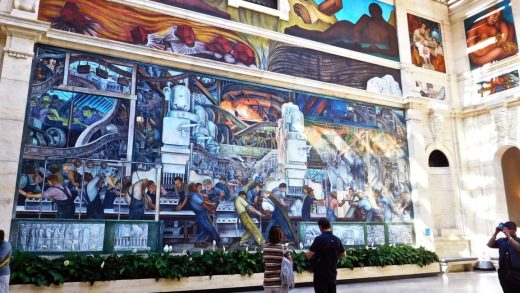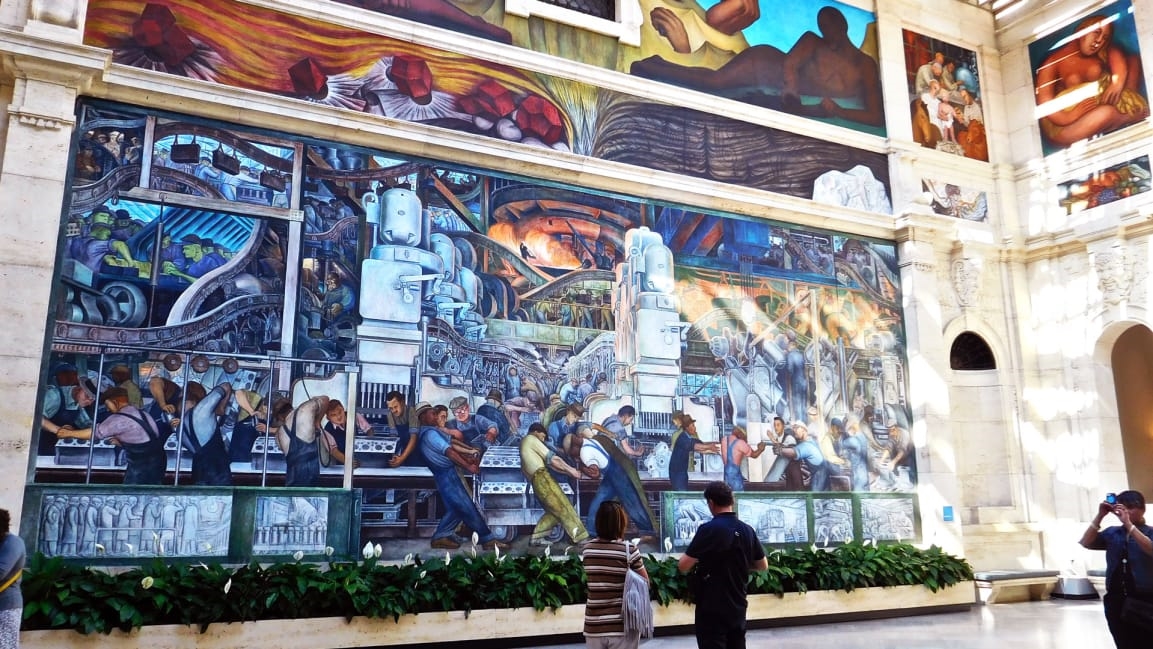These high schoolers visited the heartland and re-imagined America’s future
When Diego Rivera painted his famous Detroit Industry Murals during the Great Depression, he captured a sense of wistfulness shared by many across the United States.
Through his colorful panels, he showcased an era “before the 1929 stock market crash, when industrial productivity, employment, and wages were at their height,” art historian Linda Bank Downs has noted. Yet at the same time, it was lost on no one that this “golden age” had crumbled, resulting in “an atmosphere of self-doubt, fear of the future, and blame of the industrialists” for having “abdicated moral economy.”
Eighty-five years later, it’s hard not to gaze at these remarkable frescos and wonder: How might Rivera interpret today’s world of work? What, for that matter, should any of us conclude when the unemployment rate is extremely low, corporate profits are surging, and GDP growth has been strong, but so many folks still find themselves left behind?
During a recent trip to Detroit, I not only had the chance to reflect on these questions, I had the privilege of considering them through the eyes of 19 high school students who’d traveled to Michigan to study the fall of industrial America—not just the collapse in the 1930s, but the hollowing out of millions of middle-class jobs over the past several decades.
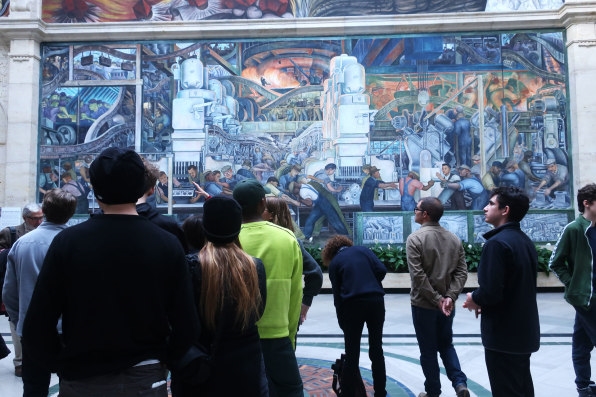
[Photo: Teva Corwin]
The course, which I co-taught, was part of a special two-week immersion session at Oakwood School in Los Angeles, where each December, the regular curriculum is suspended so that students can take a deep dive into one subject. (My son and daughter are Oakwood graduates.)
Oakwood is a private school, and most of the families that go there are extraordinarily privileged. Exposing students to the fact that about half of all working people in the U.S. earn less than $30,000 a year was, in itself, bound to be eye-opening. “It was piercing the bubble in which these kids live,” says Victor Cohen, an Oakwood social studies teacher who designed and led the class with me.
As a final group project, our 10th, 11th, and 12th graders summoned their inner Diego Rivera and made their own industry mural for the 21st century—a stinging commentary, as it turned out, on a society in which the overwhelming majority of workers don’t partake in the prosperity they produce nearly to the degree that they once did.
First, though, there was much to absorb.
Fourth-grade skills in a knowledge economy
After landing in Detroit, we had dinner at Slows Bar BQ with Nicole Sherard-Freeman, president of the city’s workforce agency, who explained how local public schools have, far too often, left a generation ill-equipped to land a decent job in an economy that increasingly rewards knowledge and skills.
In a distressing number of cases, graduates are “doing really well if they read and do math at a ninth-grade level,” she said. “Many are at a fourth-grade level.”
The next morning, the class sifted through boxes at the United Auto Workers archives and chatted with Paul Massaron, a longtime union official, who spoke of how automation had eaten away at lots of well-paid factory jobs. He was quick to add, however, that at least some of the work now largely performed by robots—like painting automobiles—wasn’t fit for humans in the first place.
It used to be that “if you were painting cars red, you coughed red that day,” Massaron recalled. “If you were painting them blue, you coughed blue.”
We toured Ford’s Rouge Factory, which Rivera depicts in his murals, and where these days the F-150 pickup is manufactured.
We visited the General Motors Heritage Center, where the students marveled at a panoply of sparkling vintage vehicles—while trying to understand why a company that had posted more than $3 billion in third-quarter operating profit had just announced it would idle five factories and eliminate 14,000 jobs. The answer, according to the executive who briefed us: Customers aren’t buying small sedans anymore, preferring trucks, SUVs, and crossovers instead. If CEO Mary Barra hadn’t made these “tough decisions,” he said, GM might have jeopardized its long-term financial viability, necessitating far more severe cuts down the road.
The next morning, the students heard a much different take from activists at the Boggs Center, who criticized GM for putting profits over people.
We attended services at Church of the Messiah, a congregation determined to create jobs as well as save souls. And we hung out with Joann Castle and Greg Hicks, both of whom were instrumental in the League of Revolutionary Black Workers, which in the late 1960s battled against exploitation and discrimination at the auto plants and within the United Automobile Workers (UAW). They’ve continued to fight for those without much power ever since.
“There’s always going to be a movement where people are struggling,” Castle told the class. “It’s like a river that just keeps on going.”
Venturing into Trump country
On our last day in the area, we headed an hour south of Detroit to Monroe, which had twice backed Barack Obama for the White House before flipping to Donald Trump by more than 20 points. To start the day, the students gathered with their peers from the big public high school, where they compared and contrasted their lives as teenagers—”Everyone loves Travis Scott.” “There’s more opportunity in L.A.”— and made some new friends.
At Monroe County Community College, we engaged with a panel of Trump supporters, who expressed admiration for the president’s policies—if not always his rhetoric—on immigration and trade. “Jobs are coming back,” declared Leigh Cole, a retired Marine from Monroe.
Nonetheless, concerns remain.
“We don’t have $40-an-hour union jobs like we used to,” said Joe Bellino, the Republican state lawmaker who represents the area, pointing to a Ford plant that shuttered about 10 years ago, during the Great Recession, taking out 1,200 positions.
Longer term, Bellino said, his real worry isn’t that any particular factory will close. As cars become more high-tech—essentially computers on wheels—the entire industry could shift out of the region to, say, California, or other places with a better-trained workforce.
“We might wake up one day and not have an auto business,” Bellino said. “That scares the bejesus out of us.”
Our last stop was Flint, where we met with Mona Hanna-Attisha, the pediatrician who helped blow the whistle on the city’s water crisis, and State Senate Minority Leader Jim Ananich (D-MI).
In the mid-1960s, we learned, Flint boasted the highest per-capita income in the country. But as GM jobs began to dry up in the 1980s, the city fell into a downward spiral, and it’s now counted among the poorest and most violent in the U.S.
“It’s all the lists you don’t want to be on,” Ananich said.
When we got back to Los Angeles, we were joined by two closing speakers: Laphonza Butler, president of Local 2015 of the Service Employees International Union, and Carmen Rojas, CEO of The Workers Lab.
Each highlighted ways in which they and their colleagues are improving conditions for low-wage workers—undertaking successful SEIU organizing drives, sparking the Fight for $15, launching worker-owned co-ops—but acknowledged that even these triumphs have left people short of what they need to make ends meet.
As a nation, we’ve chosen for people to scrap “for the bare minimum,” Rojas said. “It’s just-enoughism.”
“We have to demand more,” Butler asserted.
Commentary in chalk
Having taken in so much, it was finally time to make the mural. Armed with chalk, the students covered an 8-by-12-foot wall with an array of images representing four overarching themes.
The first, which spreads across the top of the piece and consumes the middle section, is the ongoing threat of automation—especially to workers engaged in repetitive tasks. The class had been struck by how Ford featured giant robotic arms, not human hands, during a gaudy display of how the F-150 is assembled.
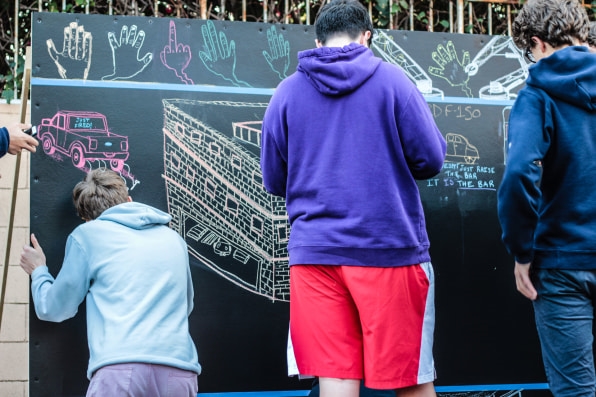
[Photo: Avery Carey]
The second theme, which runs in a triptych along the bottom of the mural, is the rise and decline of organized labor. It begins with a drawing of the 1937 Flint Sit-Down Strike—a work stoppage that, as Hanna-Attisha had described to us in Flint, had propelled the UAW into prominence and, in turn, “birthed the middle class.” The series ends with the logo for the Fight for $15, a wage that the students couldn’t imagine trying to survive on.
“That’s not the middle class,” says Lucy Cameron, a 10th grader. “That’s not enough money. That’s just not a lot at all.”
The third theme is abandonment, punctuated by a portrayal of a mothballed factory, a Ford truck marked with a “Just Fired” sign, and a “GM baby” clutching a fistful of cash.
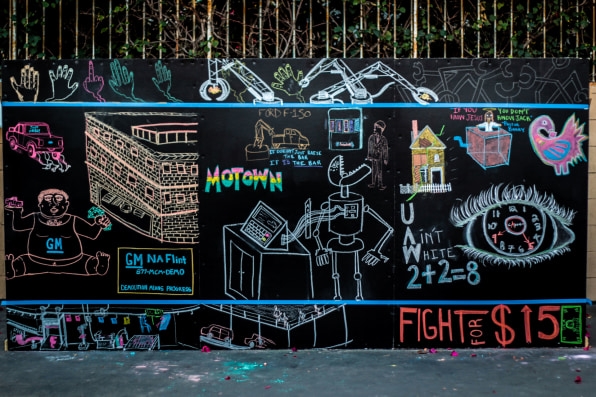
Oscar Haas, a 17-year-old senior who lampooned GM, says he actually appreciated the argument that if the automaker hadn’t gotten ahead of consumer trends by reducing its payroll, it could “wind up hemorrhaging tons of money.”
“I am definitely sympathetic to the company,” he says. But he ultimately couldn’t get past the plight of the workers–“those who got the short end of the stick.”
The fourth theme is resilience. Inspired by all of those who have dedicated themselves to lifting up their communities amid so much despair, the students drew a collection of symbols, including the mythical Sankofa bird, which flies forward but looks backward while carrying an egg in its mouth. It has been adopted by residents in Flint as a reminder to persevere but never forget all that happened, and to prioritize the young.
Also in that portion of the mural is 2 +2 = 8, a formula we discovered at the Heidelberg Project, an outdoor art space in Detroit, which pushes us to expand our thinking and not automatically accept that things will forever be the way they are.
As the class wrapped up, the students emphasized that there were no easy solutions to the problems they’d observed. They also stressed that the past was far from perfect, especially for people of color. “We tend to over-romanticize the 1950s,” says Julia Smith, a senior.
Still, “something’s changed,” she says. “In the ’50s, people with a regular job could have a house with a white picket fence and provide for their kids. Now they can’t.”
For these students, the central takeaway was clear: For all too many hard-working Americans, it’s not a pretty picture.
(51)

